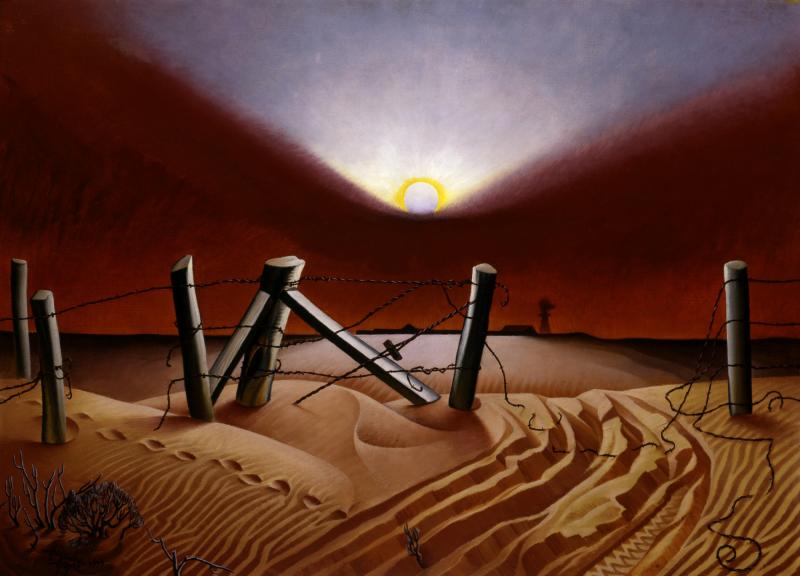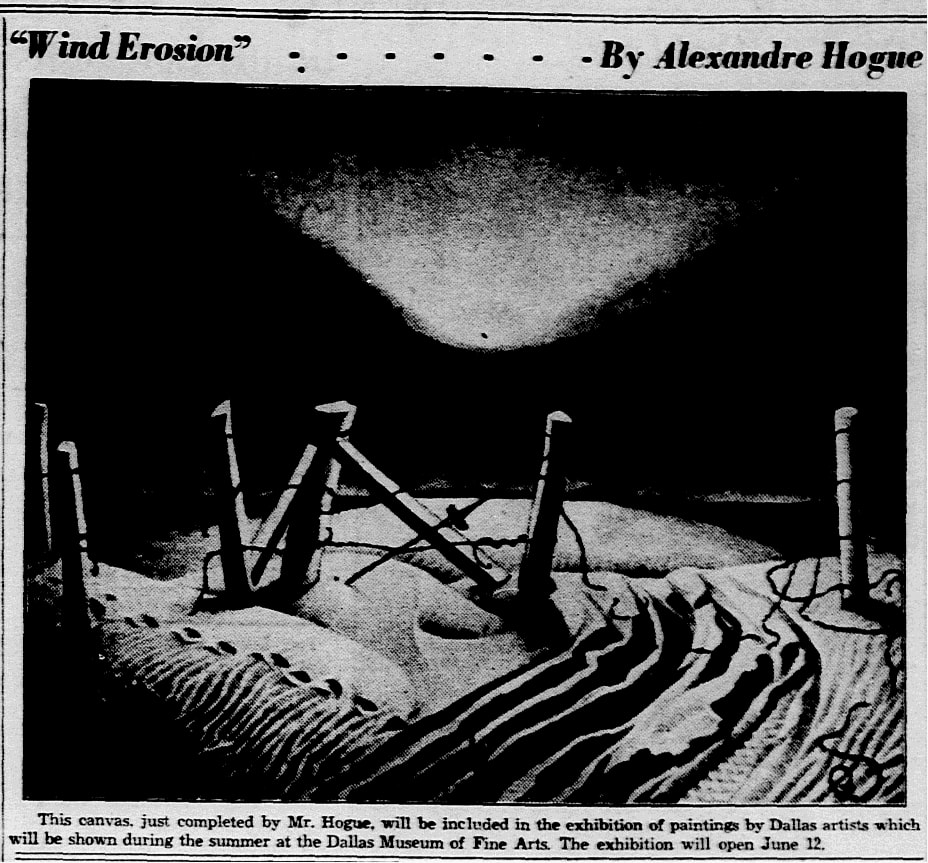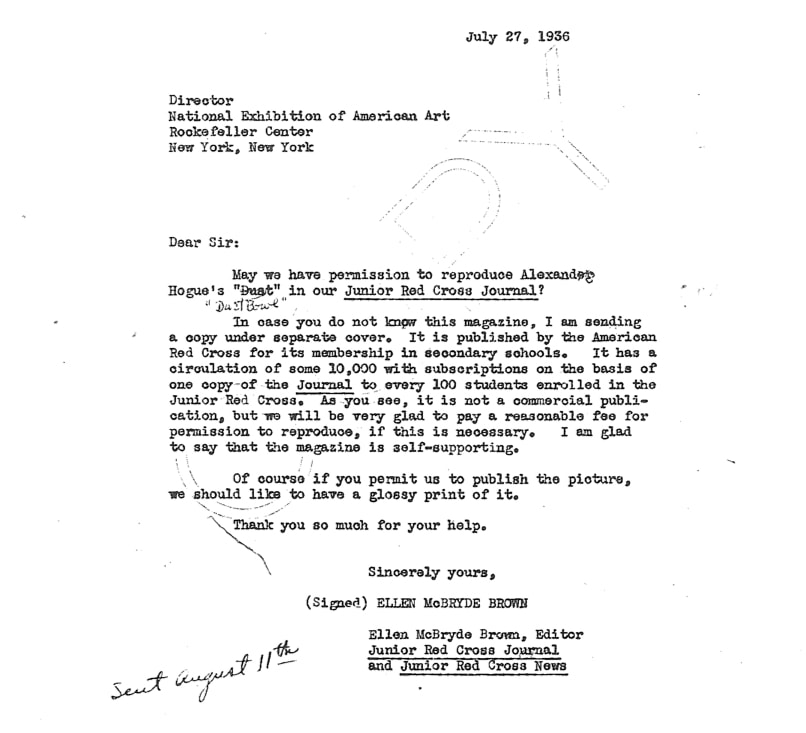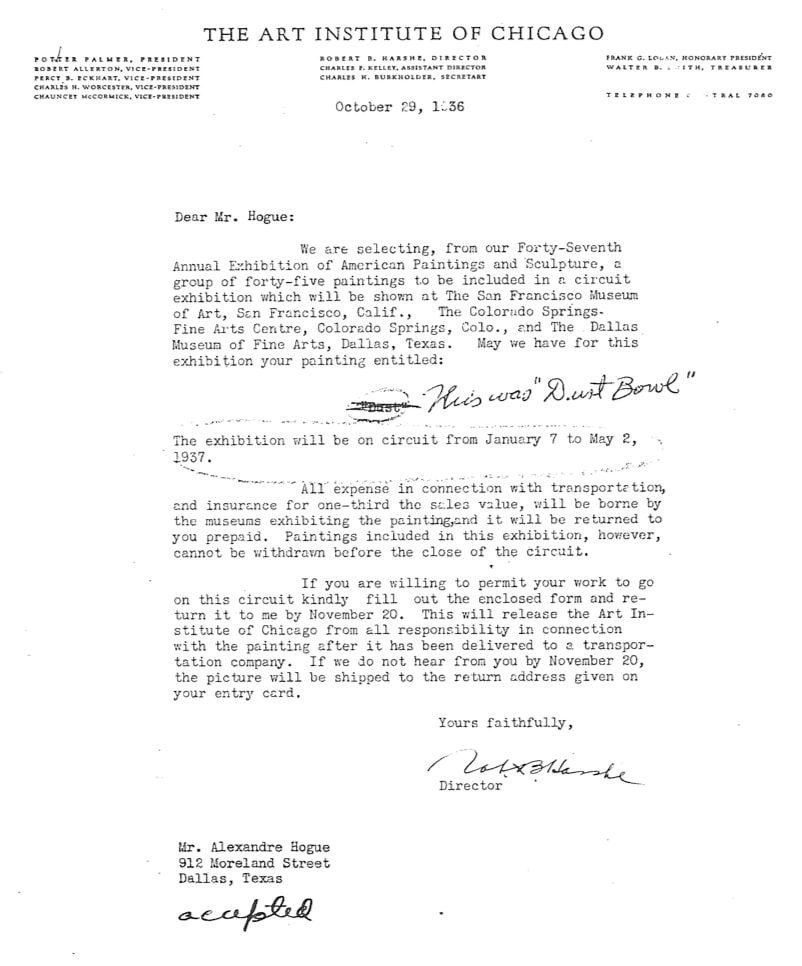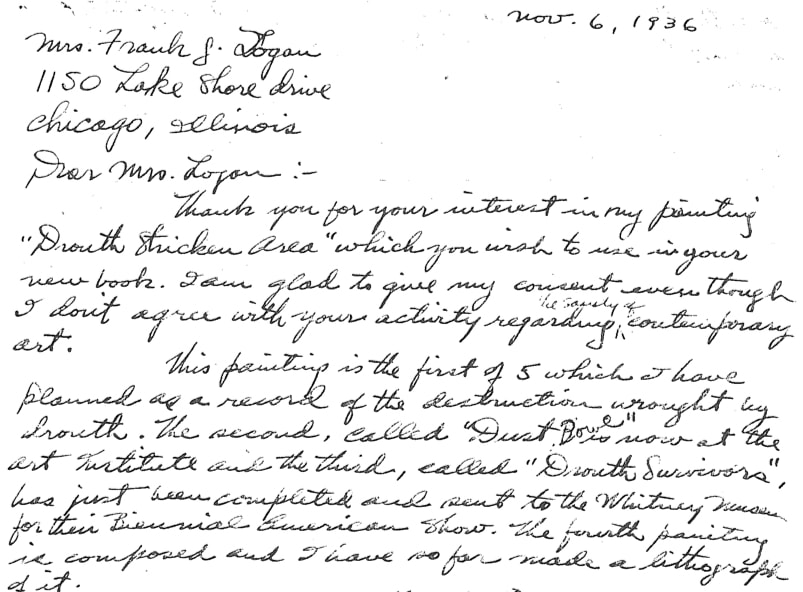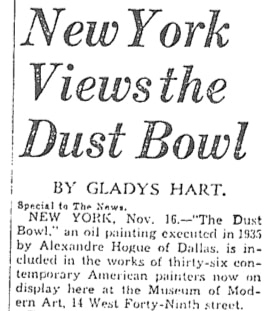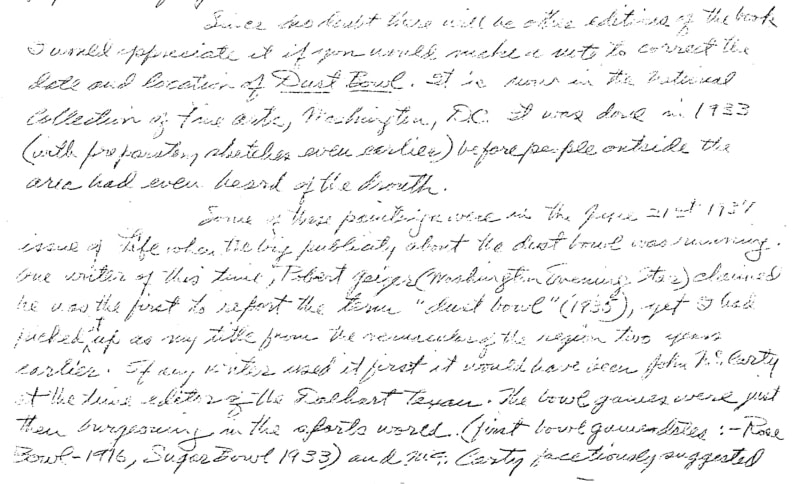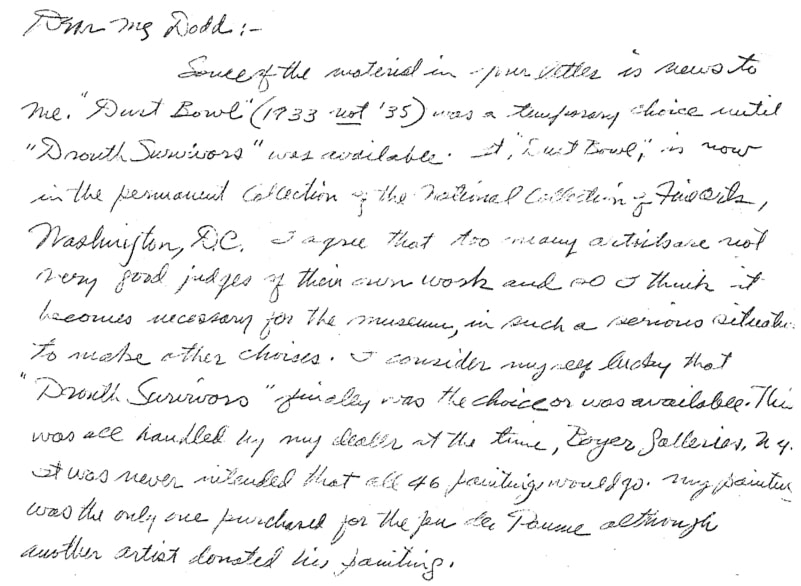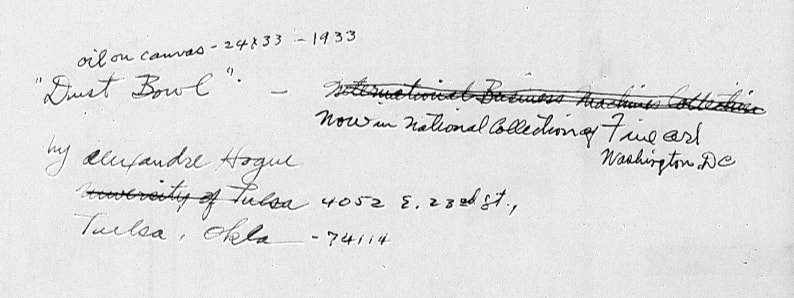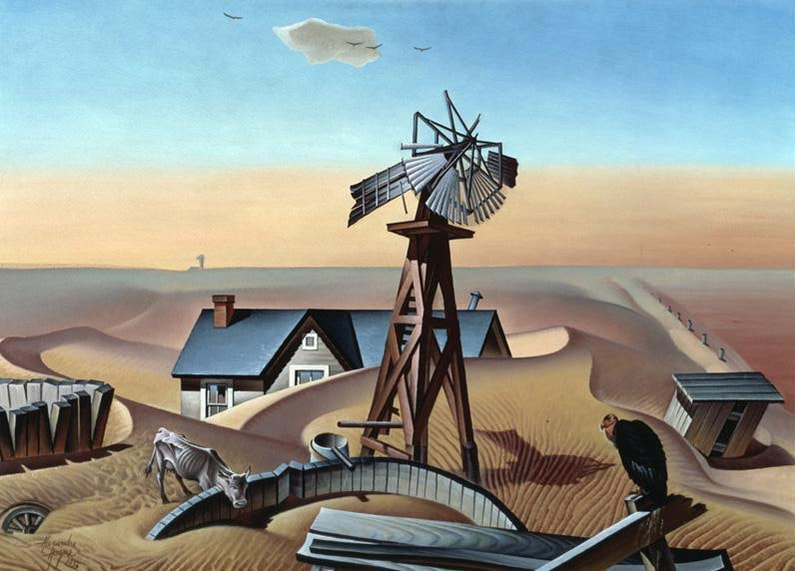|
Following Alexandre Hogue’s rise in popularity from his painting Drouth Stricken Area in 1934, Hogue decided to create a series of paintings on the destruction brought by the drought in the 1930’s. Hogue divided his paintings on the drought into two categories, wind and water erosion. Dust Bowl was completed in 1935 as Hogue’s second painting in his series on wind erosion (Figure 1). Dust Bowl went through a series of title changes in the 1930’s. After completion, the painting was originally titled Wind Erosion. However in 1936, Hogue began to refer to his painting as Dust. It was not until 1937 Hogue would refer to the title of his painting as Dust Bowl. In addition to the name change in 1937, Hogue later attempted to cross out all records of alternative titles in his letters. This was due to his claim that he was the inventor of the term “Dust Bowl” before reporters had used the term to describe the area in 1935. According to Alexandre Hogue: An American Visionary (Texas A&M University Press, 2011), Hogue painted Dust Bowl in 1933. However, letters in the Smithsonian Archives of American Art reveal Hogue completed Dust Bowl in 1935. The first record of the painting Dust Bowl by Hogue was in an article from June 2, 1935 (Figure 2). A photograph of the painting was printed but with the title Wind Erosion instead. The article was an announcement of the painting’s inclusion in an upcoming exhibit at the Dallas Museum of Fine Arts. The text in the article states the painting was “just completed” by Hogue. Figure 2. “Wind Erosion,”Dallas Morning News, June 2, 1935. In a letter from Ellen Brown to Hogue on July 27, 1936, Brown asked permission to reproduce Hogue’s painting Dust in the upcoming American Red Cross Journal (Figure 3). This was the first time the painting was referred to as Dust, which Hogue crossed out and wrote in Dust Bowl at a later date. Figure 3. Alexandre Hogue, letter from Ellen McBryde Brown to Alexandre Hogue, July 27, 1936. Archives of American Art, Smithsonian Institution, Reel No. 1481. Another example where Hogue crossed out Dust and wrote Dust Bowl was this letter from The Art Institute of Chicago to Hogue on October 29, 1936 (Figure 4). Figure 4. Alexandre Hogue, letter from The Art Institute of Chicago to Alexandre Hogue, October 29, 1936. Archives of American Art, Smithsonian Institution, Reel No. 1481. In a letter to Mrs. Frank Logan on November 6, 1936, Hogue explained his vision for his series on the drought (Figure 5). He writes Drouth Stricken Area was the “first of five” paintings he planned for the series. He then went on to say “the second, Dust is now at the art institute…” and squeezed the word “Bowl” into the sentence at a later date. Based on this letter, Dust Bowl would have been painted after Drought Stricken Area. Figure 5. Alexandre Hogue, letter from Alexandre Hogue to Mrs. Frank Logan, November 6, 1936. Archives of American Art, Smithsonian Institution, Reel No. 1482. The first time Hogue referred to his painting as Dust Bowl without writing the term in later or correcting the title was in his letter to Wellington Brink on January 18, 1937 (Figure 6). Wellington had asked Hogue for photographs of his paintings to be reproduced in the upcoming Soil Conservation. In this letter, Dust Bowl is clearly written out with no sign of alteration. In parenthesis Hogue wrote “notice this title instead of Dust.” The March 1937 issue of Soil Conservationwas the first time the painting was reproduced with the title Dust Bowl. Figure 6. Alexandre Hogue, letter from Alexandre Hogue to Wellington Brink, January 18, 1937. Archives of American Art, Smithsonian Institution, Reel No. 1481. A Dallas Morning News article on November 17, 1937 helps to give further proof of the completion of Dust Bowl in 1935 (Figure 7). The article was an announcement of Hogue’s upcoming exhibit at the Museum of Modern Art in New York City and began by stating Hogue’s Dust Bowl was “an oil painting executed in 1935.” Figure 7. “New York Views the Dust Bowl,” Dallas Morning News, November 17, 1937. In the 1970’s Hogue began to backdate his painting Dust Bowl in order to prove he was the first to use the term “Dust Bowl” (Figure 8). In a letter to John Baur on November 9, 1972, Hogue claimed he painted Dust Bowl in 1933 “before people outside the area has heard about the drouth” and claimed he picked out the title two years before the reporters used the term in 1935. Figure 8. Alexandre Hogue, letter from Alexandre Hogue to John Baur, November 9, 1972. Archives of American Art, Smithsonian Institution, Reel No. 1482. In a letter to Diana Dodd on November 22, 1975, Hogue attempted to backdate his painting again by writing “1933 not 35” (Figure 9). Figure 9. Alexandre Hogue, letter from Alexandre Hogue to Diana Dodd, November 22, 1975. Archives of American Art, Smithsonian Institution, Reel No. 1482. When donating his letters to the Smithsonian Archives of American Art in the 1979, Hogue included photographs of his paintings where he gave a brief description. Alongside the photograph of Dust Bowl, Hogue backdated his painting to 1933 (Figure 10). Figure 10. Alexandre Hogue, “Description of paintings,” 1979. Archives of American Art, Smithsonian Institution, Reel No. 1482. Hogue’s incorrect claim to the 1933 date in 1979 is most likely what ledthe painting to be dated 1933 in Alexandre Hogue: An American Visionary. However, the letters in the Smithsonian Archives of American Art give evidence of the painting’s creation in 1935. The 1933 claim of the painting’s completion was an effort by Hogue to prove his invention of term “Dust Bowl” before reporters used the term in 1935. Russell Tether, President Katherine Hillman, Associate Russell Tether Fine Arts Associates, LLC
Comments are closed.
|

